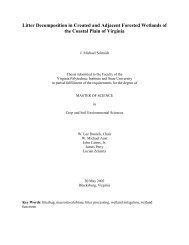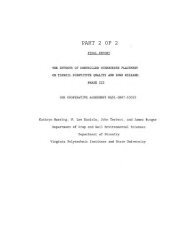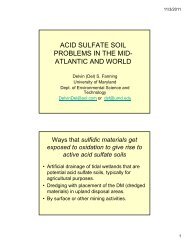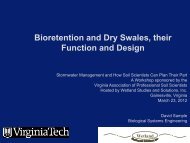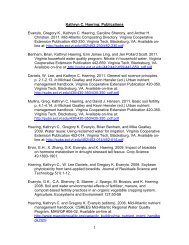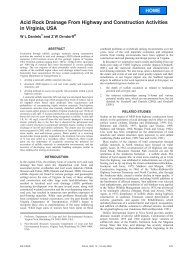Remediation of PAH-Contaminated Soils and Sediments: A ...
Remediation of PAH-Contaminated Soils and Sediments: A ...
Remediation of PAH-Contaminated Soils and Sediments: A ...
You also want an ePaper? Increase the reach of your titles
YUMPU automatically turns print PDFs into web optimized ePapers that Google loves.
Composting<br />
Composting is a form <strong>of</strong> biostimulation because it consists <strong>of</strong> nutrient additions,<br />
moisture <strong>and</strong> oxygen control in a contained system. In a properly-maintained<br />
compost pile, temperatures in excess <strong>of</strong> 55˚C are reached which kills most<br />
pathogens (Eweis et al., 1998) <strong>and</strong> is a technique most commonly used for<br />
treatment <strong>of</strong> municipal solid wastes. In applications for hazardous waste,<br />
contaminant organic compound concentrations <strong>and</strong> extremely high temperatures<br />
(>55˚C) cannot support microbial activity in a composting environment <strong>and</strong><br />
additional organics must be added <strong>and</strong> temperatures controlled (Eweis et al.,<br />
1998).<br />
Like all bioremediation techniques, composting is effective only if implemented<br />
properly. Optimization <strong>of</strong> four parameters is necessary for successful <strong>PAH</strong><br />
degradation during composting; aeration, temperature, moisture <strong>and</strong> pH.<br />
Composting is a generally aerobic process with microsites <strong>of</strong> anaerobic activity;<br />
therefore, the pile must be aerated through mechanical mixing or additions <strong>of</strong><br />
bulking agents to improve structure <strong>and</strong> porosity. Temperature <strong>of</strong> the pile must<br />
remain between 30 <strong>and</strong> 60˚C for optimal microbial community structure, solubility<br />
<strong>and</strong> mass transfer rates (Eweis et al., 1998). Addition <strong>of</strong> organic material, while<br />
maintaining a C:N ratio for 25:1, facilitates higher temperatures in compost piles<br />
<strong>and</strong> biodegradation. Moisture must be manipulated through water <strong>and</strong><br />
amendment additions. Most compost piles are able to reach high temperatures<br />
with low moisture contents. To obtain optimum moisture content in the pile (50-<br />
80%), a bulking agent (wood chips <strong>and</strong> sewage sludge) can be added (Epstein<br />
<strong>and</strong> Alpert, 1980).<br />
There are three types <strong>of</strong> composting systems; windrow, static piles <strong>and</strong> closed<br />
reactors (Eweis et al., 1998). Open systems (windrow <strong>and</strong> static piles) are more<br />
commonly used than the closed reactors. In a windrow system, the compost<br />
mixture is placed on an impermeable layer to prevent leaching <strong>of</strong> contaminants.<br />
The cross section <strong>of</strong> the pile must be such that high temperatures are maintained<br />
on the interior <strong>of</strong> the pile with minimal heat losses on the outside <strong>of</strong> the pile.<br />
Aeration is achieved through mechanical mixing (front end loader or turner). If<br />
the pile is too large to mix, pipes can be installed to increase aeration in the pile.<br />
Windrow piles are <strong>of</strong>ten covered with a high density, polyethelyne material or<br />
wood chips in outside environments to prevent leaching from the pile during<br />
rainfall events (Eweis et al., 1998). In static piles, compost material is placed on<br />
an impermeable platform with perforated pipes connected to a blower system.<br />
Piles are aeriated at either a fixed rate or variable rate depending on the<br />
microbial activity. Static piles are also covered with plastic sheeting, but the<br />
cover must allow air to enter the pile. Closed reactors are the least used<br />
systems because <strong>of</strong> size limitations, but are the most controlled. Closed systems<br />
are constructed as the name implies <strong>and</strong> contain mixing devices through drum<br />
rotation or mixing instruments within the tank (Eweis et al., 1998).<br />
49



